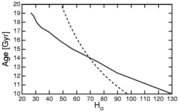An Older but Larger Universe?05 Aug 2006 - Ohio State astronomers have measured a new precise distance to the nearby galaxy M33 based on a spectroscopic eclipsing binary. Their value is 15% larger than the old Cepheid based distance. By itself this says nothing about the Hubble constant because M33 is so close to the Milky Way that its radial velocity is dominated by random motions, not the expansion of the Universe. But it could indicate that Cepheid distances are incorrect by 15%.
If so, the Hubble constant would be smaller: about 61 instead of 72 km/sec/Mpc. But the claim in the OSU press release that "the universe could be [...] 15 percent older" is incorrect. If the Hubble constant is lower, then CMB anisotropy data require that OmegaM, the ratio of the matter density to the critical density, be higher, so the vacuum energy is lower, and the change in the age of the universe is considerably smaller, as shown in graph at right
above [click on the graph to enlarge] which shows the age vs. Ho for CMB consistent models as the solid curve, and the 1/Ho behavior assumed by the OSU press release as the dashed curve. So the Universe would not be 15% older but perhaps 7% older.
The claim that the Universe would be 15% larger is partially incorrect. Even though relatively nearby galaxies would be 15% further away the actual size of the Universe would go from infinite (flat) to finite (closed) but very big, which is a smaller Universe. The distance to distant quasars at redshift z=6 would increase by only 4%, and the distance to the last scattering surface changes less than 0.5% because this is what is fixed by the CMB.
CNN quoting space.com and John Johnson of the LA Times accepted the press release's claims of a 15% older and larger Universe uncritically. The real news is that a new method for precision distance measurements has achieved its first result. It will be averaged in with other methods used to calibrate the Cepheid period-luminosity relation and lead to a few percent decrease in the Hubble constant.
One of the methods to be averaged will be the Sunyaev-Zeldovich effect which gives Ho = 77 +/- 10 km/sec/Mpc according to a recent paper. This agrees with the values of Ho from WMAP and HST quite well.
Elsewhere on his website, Ned notes other, more recent (?) research that tends to corroborate the current value of the the Hubble constant.
